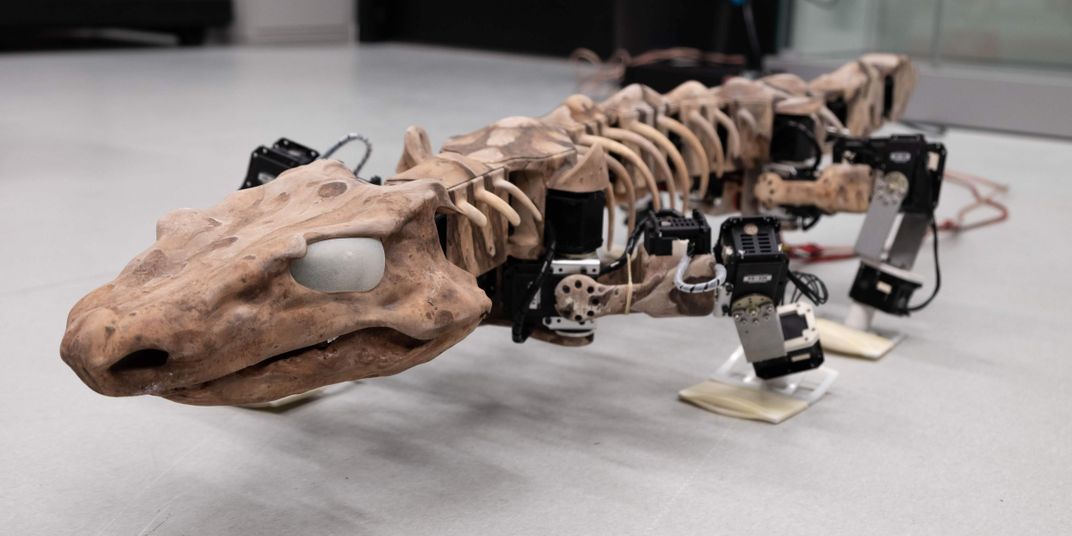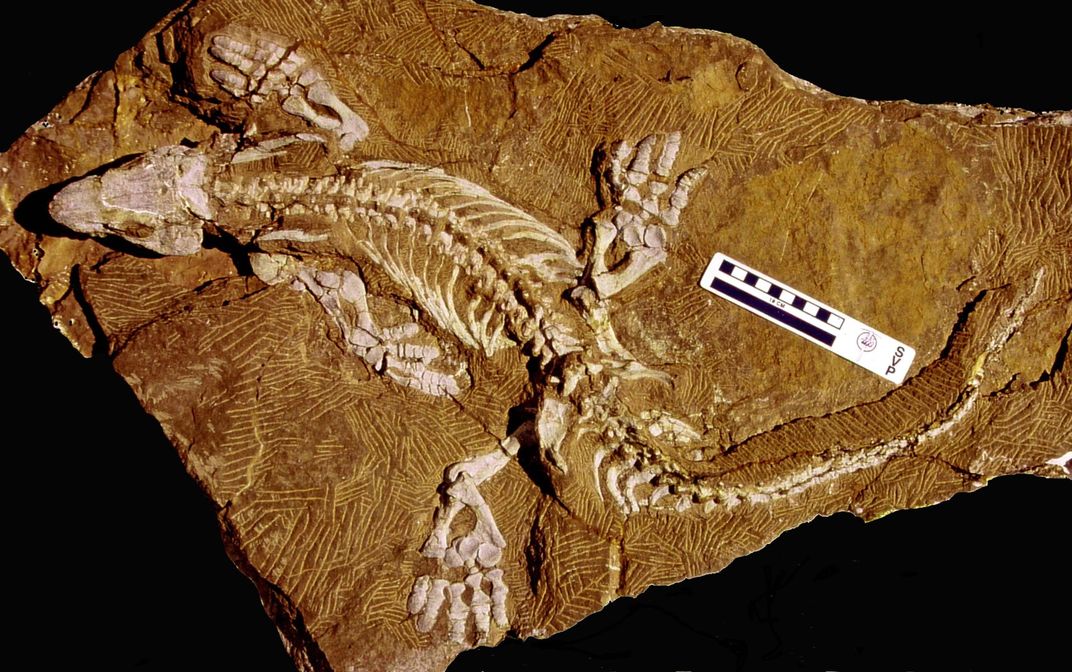Scientists Used a Robot to Study How Prehistoric Lizards Walked
OroBOT, a robot version of an ancestor to the dinosaurs, is helping fill in some gaps in the evolution of walking
:focal(1000x800:1001x801)/https://tf-cmsv2-smithsonianmag-media.s3.amazonaws.com/filer/37/33/37336de7-5946-4dbb-8d39-637e3287d677/artistic-illustration.jpg)
Paleontologists face a constant dilemma. The organisms that inspire their scientific attention are long dead, impossible to watch in life. Sci-fi solutions like bringing species back from extinction or time travel aren’t available to assist. But by combining exceptional fossils with robotics, a team of researchers has reconstructed how one of our distant, lizard-like relatives walked tall.
A fortuitous pairing of fossils provided a place to start. At first glance, the 300 million-year-old Orobates pabsti might look like a chunky lizard. In actuality, this animal from the Permian period is what experts know as a stem amniote—a vertebrate that’s part of the evolutionary lineage between amphibians, which reproduce in the water, and the last common ancestor of mammals and reptiles, which lay eggs on land. And what makes Orobates stand out is that fossil skeletons of this animal have been found with tracks the creatures made in life.
The combination of skeletons and tracks made by Orobates is exceptionally rare in the fossil record. Most tracks are found without any bones associated with them, making it difficult to tell exactly what species made the footprints. Orobates is an exception, allowing details of how the animal walked to be directly tied back to the anatomy of the skeleton.

“This constitutes a very rare track-trackmaker association, especially considering the age of the fossils,” says John Nyakatura, a biomechanics expert at Humboldt University of Berlin. Finding the skeleton along with the tracks presents an exciting opportunity for paleontologists, as Orobates sits at an important juncture in life’s evolutionary backstory. “Orobates can be considered a key fossil for the understanding of vertebrate evolution since it is a very close cousin of the last common ancestors of mammals, reptiles and birds,” Nyakatura says. Therefore, Orobates represents the creatures in between the first vertebrates to drag themselves onto land and the lizard-like animals who led full-time terrestrial lives.
In a new Nature study, Nyakatura and his colleagues combined fossils, studies of living animals, and hardware to build a robotic replica of Orobates, called OroBOT. With a walking robot to take this long-extinct animal through its paces, the researchers were able to “open the black box of inference,” Nyakatura says, and determine the most likely way that Orobates moved.
Biomechanics experts have used this approach before. The Pleurobot, designed to study how salamanders move, demonstrated that robotics can provide insights into the anatomy of living creatures. OroBOT takes the same logic back through Deep Time, drawing from studies of how salamanders, skinks, iguanas and caimans get around. Nyakatura and his team gave their robotic Orobates different stances and gaits to measure the resulting footprint patterns and then compared the results to the fossilized tracks left by the living animal hundreds of millions of years ago.
“We first studied the locomotion of extant species in great detail to get a better understanding of the mechanical properties of sprawling tetrapod locomotion,” Nyakatura says. These investigations allowed the researchers to identify biomechanical patterns which were applied to their models of tetrapod movement. The fossil footprints acted as a check on the computer simulations, and the motion of the OroBOT used the simulations to match the pattern of the footprints.
“The approach is comprehensive, transparent and explicitly evidence-based,” NYIT paleontologist Julia Molnar says. “I think that many other researchers in this field will adopt aspects of their methodology.”
As it turns out, the way modern caimans move is a good analogue for Orobates. The prehistoric ancestor to lizards held its body off the ground on flexed limbs, with a slight side-to-side motion as it walked. This type of movement differs from what paleontologists expected. The predecessors of Orobates, Molnar says, “are usually characterized as salamander-like in their locomotion, fully sprawling and maybe dragging their bellies on the ground.”

While it may seem like a slight shift in behavior, lifting the belly off the ground while walking represents a major change from partially aquatic animals, which drag their bodies almost like they are swimming on land, and animals that evolved to walk primarily on solid ground. “Other researchers previously assumed that the advanced locomotion that we inferred for Orobates only arose after the origin of amniotes,” Nyakatura says, but the new results indicate that these more specialized ways on moving around on land evolved much earlier.
The mechanics of the OroBOT are specifically keyed to Orobates, but the research demonstrates how robotics could help unlock secrets during a critical time in life’s history. The result of the new study, Molnar says, “does suggest that stem amniotes weren’t restricted to fully-sprawling postures, and there may have been a wide variety of postures and gaits the different animals used in different situations.” Between species tied to the water and those that spent their lives entirely on land, shuffling between the aquatic and terrestrial realms, creatures like Orobates could really strut their stuff.
/https://tf-cmsv2-smithsonianmag-media.s3.amazonaws.com/accounts/headshot/RileyBlack.png)


/https://tf-cmsv2-smithsonianmag-media.s3.amazonaws.com/accounts/headshot/RileyBlack.png)

